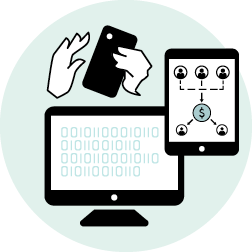While exact figures vary from survey to survey, the overall picture is clear: many Americans were living paycheck to paycheck before the global pandemic hit, and continue to do so thanks to the devastating impact of COVID-19 on the economy.
And in a double whammy, a significant number of households have accumulated debt so they can pay essential expenses in a time when they’ve faced pay cuts and job losses.
While new federal programs may offer relief to both employer and employee, businesses can help right now by implementing new paycheck options to get money into the hands of workers faster.
This is one of those instances where benefits accrue to all: by paying workers immediately, employers can improve recruiting, retention, and productivity, reduce absenteeism, and provide a much-needed service for employees, too.
Financial Instability Impacts Two-Thirds of Americans
Nearly 69 percent of people in America would experience financial difficulty if their paychecks were delayed for a week, according to results from the 2020 "Getting Paid In America" survey conducted by the American Payroll Association (APA).
Another recent survey of roughly 2,000 U.S. adults by information technology company Highland Solutions reports similar findings: nearly two-thirds of respondents (63%) said they’ve been living paycheck to paycheck since the pandemic began. That number has been increasing since March 2020 and is up from 44% the previous year.
As Americans look to cover their basic needs during COVID-19, many have taken on new debt in the process. According to respondents to the Highland Solutions survey, more than a quarter have accumulated $10,000 or more in debt, and 42% said they have taken on more debt than they normally would apart from buying a home.
The main reason? Reduced income. Almost half of the respondents said their income has decreased, and 33% said either they or a spouse or partner lost their job during the pandemic.
While some assume that living paycheck to paycheck is the result of poor financial decisions such as credit card debt and undisciplined spending, that is not the story for most. Career issues, health crises, and home loans all can contribute to financial instability. Increases in the price of such essentials as housing and medical care puts the squeeze on many Americans.
High-cost options like payday and auto title loans, which many use to meet financial needs between paychecks, may provide momentary relief, but they can be difficult to satisfy. And the fees alone for bank overdrafts, late payments, and payday loans top $170 billion each year, according to the Financial Health Network – a heavy tax on those least able to afford it. Economic disasters such as that caused by the pandemic (or the Great Recession, for another recent example) push many close to the edge, or over.
On-Demand Access to Earnings Can Help Employees . . .
While discussing the many reasons why this cycle develops and how to interrupt it takes us into deep waters, business owners can consider one way to help: flexible payment options that pay employees immediately and help eliminate the problems a typical one- or two-week payroll schedule can cause.
With such options, an employer can give employees instant access to their wages as often as they like, even at the end of every shift. Payments can be direct-deposited to an employee’s debit card and verified with built-in identity confirmation so businesses are sure the right person is receiving the payout.
While that option can benefit many employees, getting immediate access to tips and wages can be a make-or-break situation for those in the service industry and for today’s gig workers – a rapidly growing segment of the economy. More than 55 million Americans rely on freelance and contract work for part of their pay; for 44% of them, it’s their primary income source, according to Edison Research. Fast access to wages smooths out the hills and valleys of cash flow and makes the gig economy a better proposition for workers.
. . . And Employers, Too
Offering on-demand access to earnings can help employees financially, but it’s also where the win-win comes in.
Timely electronic pay – far beyond what most employees have experienced in the past – helps businesses attract and retain workers, reducing the cost of recruiting. In fact, a 2019 PYMNTS report says that more than half of the gig workers surveyed would consider switching to another job if it offered on-demand wages. It also removes the heartburn of issuing paper checks, eliminating some of the time and cost of administration. For a small business owner – as many who employ service and gig workers are – it’s one less responsibility on a plate that’s usually full to overflowing.
Finally, if you need more convincing, consider this: financial struggles that take a toll on employees affect a business’s finances, too. According to a SHRM study, 83 percent of HR professionals reported that personal financial challenges impact employee performance – in some cases, to a significant extent. A study conducted by PricewaterhouseCoopers found that almost half of employees who are worried about finances are less productive at work. Greater financial wellness among employees can mean a healthier business, too.
While real-time pay may not solve all personal financial issues, it can pull some employees back from the brink. It can stabilize a workforce, eliminate some administrative headaches, and improve the bottom line. Allowing instant access to wages is certainly a different way of thinking about pay – but one that, given the benefits, deserves serious consideration in today’s economy.
Want to learn more about MerchantE's EmployeePlus PayoutsSM?
Check out this video!

1 Income and Poverty in the United States: 2019 (census.gov)
2 Historical Income Tables: Income Inequality (census.gov)



